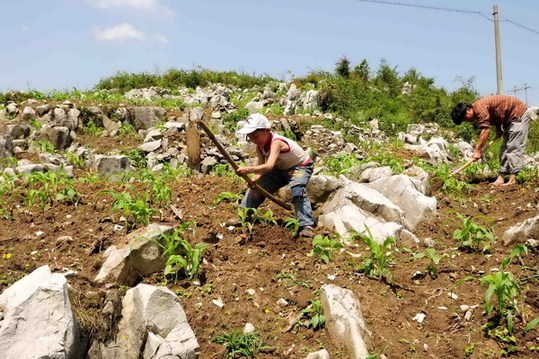Deserts still menace rivers
Updated: 2012-06-15 10:14
By Jin Zhu (China Daily)
|
||||||||
 |
|
Farmers plant corn in a stony desert area in Huishui county, Guizhou province. [Photo/China Daily] |
Millions of hectares of stony desert areas prevail in parts of South and Southwest China, posing great threats to the environment of the Yangtze and Pearl rivers, two of the country's main waterways, officials said.
The country's stony desert areas shrank to 12 million hectares by the end of 2011, down 7.4 percent from 2005, according to the latest monitoring results released by the State Forestry Administration.
The spread of stony deserts has been brought under control and the areas have been shrinking at an annual rate of 1.27 percent over the past few years, according to Zhang Yongli, deputy director of the administration, on Thursday.
"However, the country still faces severe challenges in fighting desertification as the spread of stony deserts continues due to the impact of climate change," he said.
For instance, with successive years of drought, stony desert areas now spread at an annual rate of 6.8 percent in Qujing, Yunnan province, a major headwater area of the Pearl River, according to the administration.
Of the 12 million hectares of stony desert areas, nearly 65 percent were in Guizhou, Yunnan, and Guangxi, regions frequently hit by drought and flood in recent years, Zhang said.
The country's stony desert areas now threaten the headwater areas of the Pearl River, major tributaries of the Yangtze River, as well as water source of the South-to-North Water Diversion Project and the Three Gorges reservoirs, according to the administration.
"The stony desert areas with water loss and soil erosion cause sand deposits in the lower reaches of the rivers, which pose great threats to the local environment, as well as to lives and properties along the rivers," he said.
Forestry officials said forestation and vegetation protection, as well as the application of modern agricultural technologies, contributed a lot to the ecological restoration in the stony desert regions.
At present, more than 50 million people live in the rocky regions, where desertification has resulted from water shortages, soil erosion and persistent poverty, according to the administration.
"Stony desertification and poverty are like 'twin brothers', so we combined the work to control stony desertification with the efforts to improve local people's livelihoods," said Liu Tuo, head of the Desertification Control Center under the State Forestry Administration.
Farmers had been encouraged to grow cash crops on stony lands to improve vegetation and increase earnings, he said.
Li Maosong, a researcher on disaster reduction at the Chinese Academy of Agricultural Sciences, told China Daily on Thursday that destructive farming practices, excessive land reclamation and overgrazing still exist in some rocky regions.
"For instance, farming on steep hills is quite common in those areas because of a lack of arable land, which caused severe soil erosion and speeds up the spread of stony deserts," he said.
"Government authorities should continue to increase investment in local environmental improvement and give more subsidies to support local farmers to avoid destructive farming practices," he said.
Stony desert areas are big problems in eight provinces, autonomous regions, and municipalities, such as Hunan, Guangdong, Guangxi, Chongqing and Yunnan, according to the State Forestry Administration.
jinzhu@chinadaily.com.cn

 Relief reaches isolated village
Relief reaches isolated village
 Rainfall poses new threats to quake-hit region
Rainfall poses new threats to quake-hit region
 Funerals begin for Boston bombing victims
Funerals begin for Boston bombing victims
 Quake takeaway from China's Air Force
Quake takeaway from China's Air Force
 Obama celebrates young inventors at science fair
Obama celebrates young inventors at science fair
 Earth Day marked around the world
Earth Day marked around the world
 Volunteer team helping students find sense of normalcy
Volunteer team helping students find sense of normalcy
 Ethnic groups quick to join rescue efforts
Ethnic groups quick to join rescue efforts
Most Viewed
Editor's Picks

|

|

|

|

|

|
Today's Top News
Health new priority for quake zone
Xi meets US top military officer
Japan's boats driven out of Diaoyu
China mulls online shopping legislation
Bird flu death toll rises to 22
Putin appoints new ambassador to China
Japanese ships blocked from Diaoyu Islands
Inspired by Guan, more Chinese pick up golf
US Weekly

|

|







